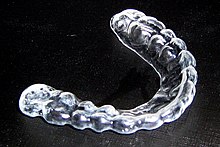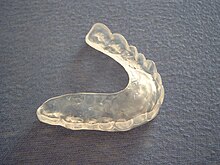Mouthguard

A mouthguard is a protective device for the mouth that covers the teeth and gums to prevent and reduce injury to the teeth, arches, lips and gums. A mouthguard is most often used to prevent injury in contact sports, as a treatment for bruxism or TMD, or as part of certain dental procedures, such as tooth bleaching. Depending on application, it may also be called a mouth protector, mouth piece, gumshield, gumguard, nightguard, occlusal splint, bite splint, or bite plane.
History
The exact origins of the mouthguard are unclear. Most evidence indicates that the concept of a mouthguard was initiated in the sport of boxing. Originally, boxers fashioned rudimentary mouthguards out of cotton, tape, sponge, or small pieces of wood. Boxers clenched the material between their teeth. These boxers had a hard time focusing on the fight and clenching their teeth at the same time.[1] Since these devices proved impractical, Woolf Krause, a British dentist, began to fashion mouthpieces for boxers in 1892. Krause placed strips of a natural rubber resin, gutta-percha, over the maxillary incisors of boxers before they entered the ring.[2] Phillip Krause, Woolf Krause’s son, is often credited with the first reusable mouthpiece. Phillip Krause’s invention was highlighted in a 1921 championship fight between Jack Britton and Ted “Kid” Lewis. Lewis was a school friend of Krauses’ and the first professional to utilize the new technology, then called a ‘gum shield.’ During the fight, Britton’s manager successfully argued that the mouthpiece was an illegal advantage. Philip Krause was an amateur boxer himself and undoubtedly used his own device before 1921. [3]
There have been other claims to the invention of the mouthguard as well. In the early 1900s, Jacob Marks created a custom fitted mouthguard in London.[4] An American dentist, Thomas A. Carlos, also developed a mouth guard at approximately the same time as Krause. Carlos claimed that he made his first mouthpiece in 1916 and later suggested his invention to the United States Olympian, Dinnie O’Keefe, in 1919. Another dentist from Chicago, E. Allen Franke, also claimed to have made many mouth guards for boxers by 1919.[5]
The mouthguard’s relevance was again brought to the center of attention in a 1927 boxing match between Jack Sharkey and Mike McTigue. McTigue was winning for most of the fight, but a chipped tooth cut his lip, and he was forced to forfeit the match. From that point on, mouthgaurds were ruled acceptable and soon became commonplace for all boxers.[6] In 1930, descriptions of mouthguards first appeared in dental literature. Dr. Clearance Mayer, a dentist and boxing inspector for the New York State Athletic Commission, described how custom mouthguards could be manufactured from impressions using wax and rubber. Steel springs were even recommended to reinforce soft materials.[7]
In the 1940s and 1950s, dental injuries were responsible for 24-50% of all football injuries.[8] In 1952, Life magazine did a report on Notre Dame football players without incisors.[9] The article drew a lot of public attention and led to the inclusion of mouthguards in other contact sports. In the 1950s, the American Dental Association (ADA) began conducting research on mouthguards and soon promoted their benefits to the public.[10]
Canadian pediatric dentist, Arthur Wood, developed a mouthguard in response to ice hockey injuries in the early 1960s. Wood referred to his device as a “mug guard” or “teeth guard.” Wood is often considered the father of the modern mouthguard.[11] In 1960, the ADA recommended the use of latex mouthguards in all contact sports. By 1962, all high school football players in the United States were required to wear mouthguards. The National Collegiate Athletic Association (NCAA) followed suit in 1973 and made mouthguards mandatory in college football. Since the induction of the mouthguard, the number of dental injuries has decreased dramatically.[12]
Mouthguards have become a standard in many sports. In addition to football, the NCAA currently requires mouthguards in ice hockey, field hockey, and lacrosse. The ADA shows that mouthguards are extremely effective in preventing facial injury in contact and non-contact sports. The ADA recommends mouthguards be used in 29 sports: acrobatics, basketball, bicycling, boxing, equestrian, football, gymnastics, handball, ice hockey, inline skating, lacrosse, martial arts, racquetball, rugby football, shot putting, skateboarding, skiing, skydiving, soccer, softball, squash, surfing, volleyball, water polo, weightlifting and wrestling.[13]
Indications
- Dental trauma
- Mouthguards are used in sports where deliberate or accidental impacts to the face and jaw may cause harm. Such impacts may occur in many sports including: baseball, boxing, mixed martial arts, puroresu, rugby, wrestling, football (soccer), American football, Australian football, lacrosse, basketball, figure skating, ice hockey, underwater hockey, field hockey, water polo, skiing, and snowboarding. Mouthguards may also prevent or reduce harm levels of concussion in the event of an injury to the jaw.[14][15] In many sports, the rules of the sport make their use compulsory,[16] or local health laws demand them. Schools also often have rules requiring their use.[17] Studies in various high risk populations for dental injuries are repeatedly reporting of a low compliance of individuals for the regular using of mouthguard during activities.[18] Moreover, even with regular use, effectiveness in prevention on dental trauma is not complete, and injuries can still occur even when mouthguards are used as users are not always aware of the best makes or size, which inevitably result in a poor fit.[19]
- Oral medicine
- Mouthguards may be used as splints to reduce strain over the temporomandibular joint in temporomandibular joint disorder
- To prevent tooth attrition in bruxism
- To deliver topical medication (e.g., corticosteroids) for chronic gingival diseases such as mucous membrane pemphigoid.
- Dental aesthetics
- During tooth bleaching
- As a night protector of thin porcelain bridges
- orthodontics
- Invisalign, a substitute for brackets and acrylic plates
Types of mouthguards
Stock or ready made
Manufactured in a pre-formed shape in various sizes but with nearly no adjustment to fit the user's mouth. The only adjustment possible is minor trimming with a knife or scissors.
Mouth adapted or "boil and bite"
A thermo-plastic material manufactured in a pre-formed shape in various sizes that can be adapted to fit more closely to an individual's teeth and gums by heating and molding such as boiling then placing in the mouth. Some are now available that incorporate special fins within the fitting zones which increase retention and give an improved fit over tradition boil and bite mouth types. Guards are usually made of Ethylene-vinyl acetate[1][2]. This is the most popular mouthguard used by amateur and semi-professional sportsmen, providing adequate protection but relatively low comfort in comparison to the custom made guard.[20]
Custom made
An impression of the user's teeth is used by specialist manufacturers to create a best-fit mouth protector. The impression may be obtained by specifically designed Home Impression kit from the guard manufacturer that uses dental putty, or from a dentist who will take an upper impression in dental alginate material. In Europe, the guard must be sold with a CE mark and the guard must have passed an EC Type-Examination test, performed by an accredited European Notified Body. Applying a CE mark without such certification is a criminal offence.
- Vacuum Form
- Custom made mouth guards using this type of machine produce single layer mouth guards
- Fit not as good as pressure laminated but offers more protection than boil and bite
- Pressure Laminated
- Custom made mouth guards using this type of machine produce multi layer mouth guards
- Offers superior fit, comfort and more protection
Dentistry

Occlusal splints (also called bite splints, bite planes, or night guards) are removable dental appliances carefully molded to fit the upper or lower arches of teeth.
They are used to protect tooth and restoration surfaces, manage mandibular (jaw) dysfunction TMD, and stabilize the jaw joints during occlusion or create space prior to restoration procedures. People prone to nocturnal bruxism, or nighttime clenching, should routinely wear occlusal splints at night.
Occlusal splints are typically made of a heat-cured acrylic resin. Soft acrylic or light cured composite, or vinyl splints may be made more quickly and cheaply, but are not as durable, and are more commonly made for short-term use. Soft splints are also used for children, because normal growth changes the fit of hard splints.
They generally cover all the teeth of the upper or lower arch, but partial coverage is sometimes used. Occlusal splints are usually used on either the upper or the lower teeth, termed maxillary splints or mandibular splints respectively, but sometimes both types are used at the same time. Maxillary splints are more common, although various situations favor mandibular splints.
Stabilizing or Michigan-type occlusal splints are generally flat against the opposing teeth, and help jaw muscle relaxation, while repositioning occlusal splints are used to reposition the jaw to improve occlusion.
See also
References
- "Tooth surface loss; Part 3: Occlusion and splint therapy" British Dental Journal, Vol. 186, No. 5, 1999-03-13, via nature.com. Retrieved on 2007-08-18.
- Widmalm, Sven E. "Bite Splints in General Dental Practice", (Website, lectures from author's homepage), University of Michigan, 2003-11-14. Retrieved on 2007-08-19.
- Widmalm, Sven E. "Use and Abuse of Bite Splints", (Website, lectures from author's homepage), University of Michigan, 2004-10-27. Retrieved on 2007-08-19.
Footnotes
- ^ Knapik, J. J., Marshall, S. W., Lee, R. B., Darakjy, S. S., Jones, S. B., Mitchener, T. A., & Jones, B. H. (2007). Mouthguards in Sport Activities. Sports Medicine, 37(2), p.120.
- ^ Reed, R. V. (1994). Origin and early history of the dental mouthpiece. British Dental Journal, 176, p. 479.
- ^ Knapik et al., 2007, p. 120.
- ^ Pontsa, Peter T. (2008). Mouth Guards Prevent Dental Trauma in Sports. The Dent-Liner 12 (3).
- ^ Knapik et al., 2007, p. 120.
- ^ Knapik et al., 2007, p. 121.
- ^ Knapik et al., 2007, p. 121.
- ^ Knapik et al., 2007, p. 121.
- ^ The fighting Irish look tough again. Life Magazine 1952; 33: 60-63.
- ^ Using Mouthguards to Reduce the Incidence and Severity of Sports-related Oral Injuries." Journal of the American Dental Association 137.12 (2006): 1712-1720.
- ^ Yabu, E. (2009). A New Generation in Athletic Mouthguards. Dental Tribune, Nov. 2009, 14A.
- ^ Knapik, et al., 2007, p. 121.
- ^ Knapik, et al., 2007, p. 121.
- ^ NZ Dental Association advice
- ^ "Do mouthguards prevent concussion?"
- ^ "...mouthguards became compulsory in 1997..."
- ^ "...mouthguards will be mandatory for all basketball and wrestling teams in the middle and upper schools...."
- ^ Zadik Y, Jeffet U, Levin L (2010). "Prevention of dental trauma in a high-risk military population: the discrepancy between knowledge and willingness to comply". Mil Med. 175 (12): 1000–1003. PMID 21265309.
{{cite journal}}: Unknown parameter|month=ignored (help)CS1 maint: multiple names: authors list (link) - ^ Zadik Y, Levin L (2008). "Orofacial injuries and mouth guard use in elite commando fighters". Mil Med. 173 (12): 1185–1187. PMID 19149336.
{{cite journal}}: Unknown parameter|month=ignored (help) - ^ Zadik Y, Levin L (2009). "Does a free-of-charge distribution of boil-and-bite mouthguards to young adult amateur sportsmen affect oral and facial trauma?". Dent Traumatol. 25 (1): 69–72. doi:10.1111/j.1600-9657.2008.00708.x. PMID 19208013.
{{cite journal}}: Unknown parameter|month=ignored (help)
